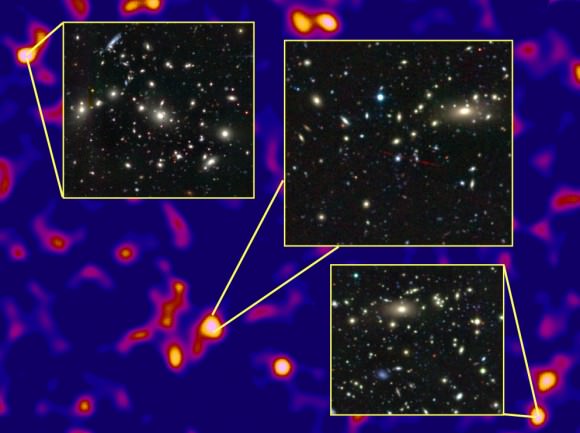We keep saying dark matter is so very hard to find. Astronomers say they can see its effects — such as gravitational lensing, or an amazing bendy feat of light that takes place when a massive galaxy brings forward light from other galaxies behind it. But defining what the heck that matter is, is proving elusive. And considering it makes up most of the universe’s matter, it would be great to know what dark matter looks like.
A new experiment — billed as the most sensitive dark matter detector in the world — spent three months searching for evidence of weakly interacting massive particles (WIMPs), which may be the basis of dark matter. So far, nothing, but researchers emphasized they have only just started work.
“Now that we understand the instrument and its backgrounds, we will continue to take data, testing for more and more elusive candidates for dark matter,” stated physicist Dan McKinsey of Yale University, who is one of the collaborators on the Large Underground Xenon (LUX) detector.

LUX operates a mile (1.6 kilometers) beneath the Earth in the state-owned Sanford Underground Research Facility, which is located in South Dakota. The underground location is perfect for this kind of work because there is little interference from cosmic ray particles.
“At the heart of the experiment is a six-foot-tall titanium tank filled with almost a third of a ton of liquid xenon, cooled to minus 150 degrees Fahrenheit. If a WIMP strikes a xenon atom it recoils from other xenon atoms and emits photons (light) and electrons. The electrons are drawn upward by an electrical field and interact with a thin layer of xenon gas at the top of the tank, releasing more photons,” stated the Lawrence Berkeley National Laboratory, which leads operations at Sanford.
“Light detectors in the top and bottom of the tank are each capable of detecting a single photon, so the locations of the two photon signals – one at the collision point, the other at the top of the tank – can be pinpointed to within a few millimeters. The energy of the interaction can be precisely measured from the brightness of the signals.”

LUX’s sensitivity for low-mass WIMPs is more than 20 times better than other detectors. That said, the detector was unable to confirm possible hints of WIMPs found in other experiments.
“Three candidate low-mass WIMP events recently reported in ultra-cold silicon detectors would have produced more than 1,600 events in LUX’s much larger detector, or one every 80 minutes in the recent run,” the laboratory added.
Don’t touch that dial yet, however. LUX plans to do more searching in the next two years. Also, the Sanford Lab is proposing an even more sensitive LUX-ZEPLIN experiment that would be 1,000 times more sensitive than LUX. No word yet on when LUX-ZEPLIN will get off the ground, however.


I’m still pulling for the MOND theory… old and discredited as that may be. I mean: Is it possible that the effects of gravity are scalar? In as far as, how does quantum field theory gravitational effects relate to our scale? Do macro gravitational effects compare somehow exponentially or logarithmically? Dzzz… Dark Matter makes my brain hurt and just doesn’t ‘feel’ right. To make it ‘feel right’, do I have to go to the next brane over?
No … 3 words: The Bullet Cluster.
MOND is dead.
I have the exact opposite way. To me, the 1/r^2 nature of gravity is so obvious and natural that tweaking it seem unreasonable. It’s easier for me to accept dark matter particles. We have neutrons, which experience gravity and the nuclear forces and neutrinos, which experience only gravity and the weak force. Why should there not be a particle that essentially experiences only gravity? Anyway, MOND is deader than dead, killed by the Bullet Cluster as Ken Lord says.
Don’t be so sure… Google ‘MOND theory’ and you’ll still find just as many arguments for as against. What’s that? Six of one and half a dozen of the other?
I don’t know anything about these theories, but I’m planning on looking into it a bit before bed. Aqua, I’d love to hear your response to the “Bullet Cluster” that the others mention.
Google “Elvis is alive” and you’ll still find as many arguments for as against…
The operators of this underground detector, the LHC and the AMS don’t appear to be certain that they can isolate suspected dark matter particles.
ESA’s soon-to-be-launched GAIA spacecraft is will give us the kick-ass map of the distribution of dark matter within the Milky way and then we’ll have plenty of good data to sift through.
“By watching for the large-scale motion of stars in our Galaxy, it will also probe the distribution of dark matter, the invisible substance thought to hold our Galaxy together.” ESA – Gaia
P.S. Thanks for bringing back Discuss. It’s not perfect, but there are even bigger issues with Google+.
The LUX experiments don’t say there is no dark matter. They say that there is no evidence for dark matter as WIMPS of a particular sort. You can still have even more weakly interacting massive particles, or even something that does not interact at all other than by gravity.
I must say I was not fond of the idea of dark matter myself when it first came out. Maybe it is just some systematic error in our observations? It would be good to have a bit of the stuff in the lab, but we haven’t got that yet. So, without direct evidence, at what point does dark matter differ from the luminiferous aether, and other stuff we can’t touch or measure?
For me, and I feel for most people, the balance comes when you can see evidence of dark matter being in one place and not in another. If if was spread out uniformly over the universe then we wouldn’t know it wasn’t just a property of space. Spiral galaxies need some considerable weight towards the outside if they are to keep their shape for a reasonable time according to classical mechanics. That is part of the evidence, but it is not a particularly good part because spiral galaxies are pretty symmetric, and adding a symmetric ring of mass is not that different to some alternative gravity theories. No, what we want is some much less symmetric event where galaxies have gone smack through each other, and the dark matter ought to overshoot the ordinary matter. The Bullet Cluster was the first of these, and the one that first convinced me.
Dark matter is not a dramatic idea. In many ways, it is the unimaginative option. Chemists did not discover the noble gases: Helium was discovered in the sun by its spectrum, and later found on earth. Neutrinos are everywhere and interact very little, so they can go clean through the earth, but we can still detect them. If there is some particle that has mass but interacts less than the neutrino, then – like the noble gases – there might be lots of it out there and we would never know. Our atmosphere was one percent noble gases. Seems the ratio is the other way around with dark matter.
That being said, I and many others would be much happier when we have identified a dark matter particle.
Easy to answer what dark matter looks like: invisible.
And someday we’ll realize it’s invisible because it doesn’t exist.